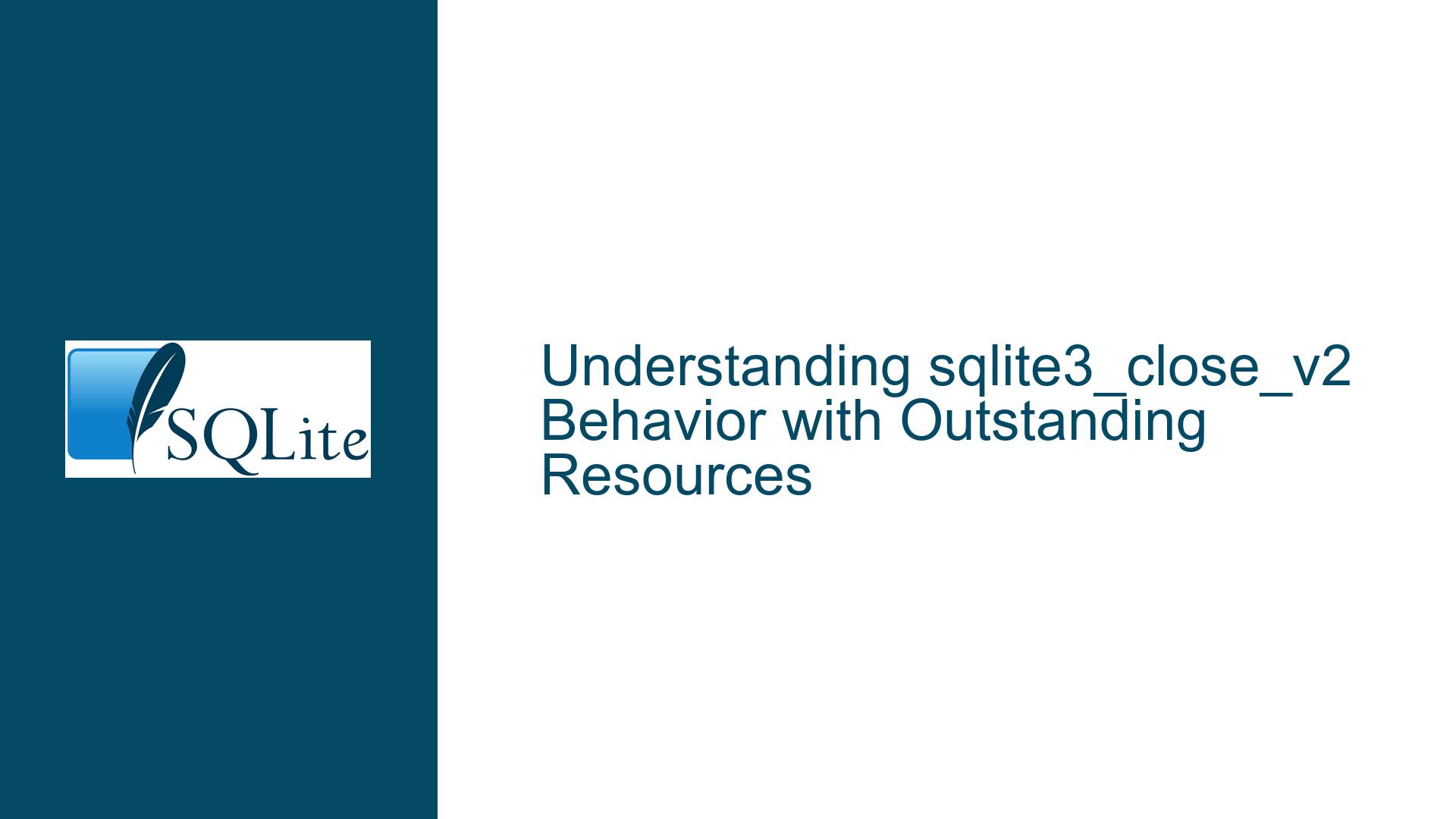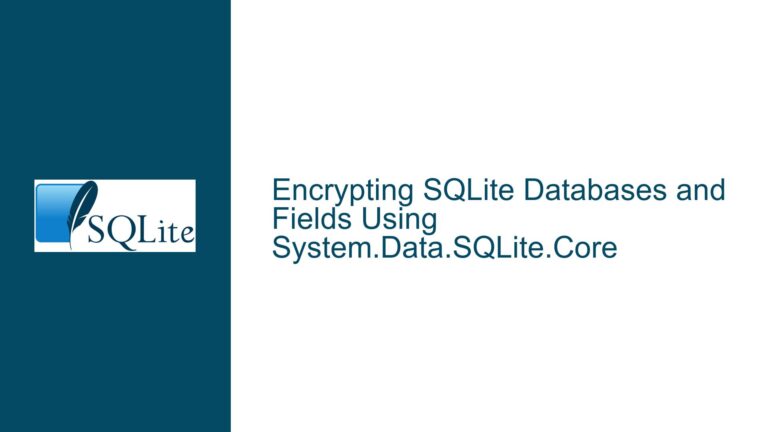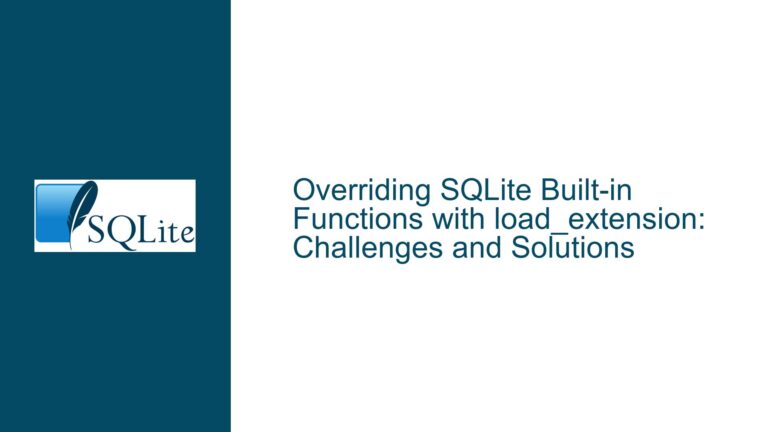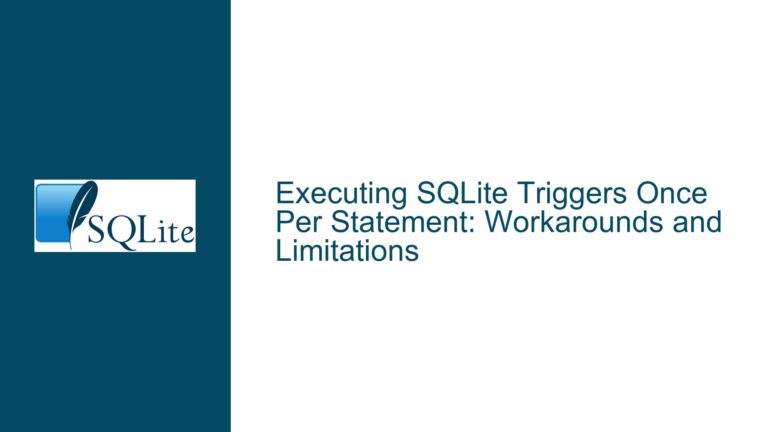sqlite3_close_v2 Behavior with Outstanding Resources
sqlite3_close_v2 and Deferred Resource Deallocation
The sqlite3_close_v2 function in SQLite is designed to close a database connection and deallocate associated resources. However, its behavior becomes nuanced when the database connection has outstanding resources such as prepared statements, BLOB handles, or sqlite3_backup objects. According to the SQLite documentation, if sqlite3_close_v2 is called on a connection with such outstanding resources, it returns SQLITE_OK immediately, but the actual deallocation of resources is deferred until all associated objects are destroyed. This deferred deallocation mechanism raises questions about whether sqlite3_close_v2 blocks until resources are cleaned up or if it returns immediately, allowing the program to terminate without waiting for resource cleanup.
The core issue revolves around understanding the blocking behavior of sqlite3_close_v2 and ensuring that resource cleanup is handled correctly to avoid memory leaks or file handle leaks. This is particularly important in environments where resource management is critical, such as long-running applications or systems with limited resources. Misunderstanding this behavior can lead to subtle bugs, where resources are not properly released, causing memory leaks or other resource exhaustion issues.
The documentation for sqlite3_close_v2 states that it defers resource deallocation but does not explicitly clarify whether the function blocks or returns immediately. This lack of clarity can lead to confusion, especially for developers who are new to SQLite or who are working in environments where resource cleanup must be handled with precision. The issue is further compounded by the fact that the order in which resources are cleaned up is not enforced, which can lead to different behaviors depending on the environment and the specific implementation.
Outstanding Resources and Non-Blocking Behavior
The primary cause of confusion around sqlite3_close_v2 stems from its handling of outstanding resources. When a database connection has outstanding prepared statements, BLOB handles, or sqlite3_backup objects, sqlite3_close_v2 does not block or wait for these resources to be cleaned up. Instead, it returns SQLITE_OK immediately, and the actual deallocation of resources is deferred until all associated objects are destroyed. This behavior is by design and is intended to provide flexibility in resource management, particularly in environments where the order of resource cleanup is not easily controlled.
The non-blocking behavior of sqlite3_close_v2 is a key feature that allows developers to close database connections without having to worry about the order in which resources are cleaned up. This is particularly useful in environments like C++, where resources are often managed by destructors, and the order of destruction may not be easily predictable. However, this flexibility also places the responsibility on the developer to ensure that all resources are properly cleaned up before the program terminates. Failure to do so can result in memory leaks or file handle leaks, which can be difficult to diagnose and fix.
The deferred deallocation mechanism is implemented internally by SQLite, which keeps track of all outstanding resources associated with a database connection. When sqlite3_close_v2 is called, SQLite marks the connection as "pending close" and waits for all associated resources to be destroyed before finally deallocating the connection. This mechanism ensures that resources are not prematurely deallocated, which could lead to undefined behavior or crashes. However, it also means that developers must be diligent in ensuring that all resources are properly cleaned up, as any outstanding resources will prevent the connection from being fully deallocated.
Ensuring Proper Resource Cleanup with sqlite3_close_v2
To ensure proper resource cleanup when using sqlite3_close_v2, developers must take care to explicitly close or finalize all outstanding resources associated with a database connection before terminating the program. This includes calling sqlite3_finalize on all prepared statements, sqlite3_blob_close on all BLOB handles, and sqlite3_backup_finish on all sqlite3_backup objects. These functions should be called in any order, as SQLite does not enforce a specific order for resource cleanup. However, it is important to ensure that all resources are properly cleaned up before the program terminates, as any outstanding resources will prevent the connection from being fully deallocated.
In environments where resource cleanup is managed by destructors, such as C++, developers should ensure that all database-related objects are properly destroyed before the program terminates. This may involve using smart pointers or other resource management techniques to ensure that resources are automatically cleaned up when they go out of scope. In environments where manual resource management is required, developers should carefully track all outstanding resources and ensure that they are properly cleaned up before calling sqlite3_close_v2.
One common pitfall is assuming that sqlite3_close_v2 will automatically clean up all outstanding resources, which is not the case. While sqlite3_close_v2 does defer resource deallocation, it does not automatically clean up resources that are still outstanding. Developers must explicitly clean up all resources before the program terminates to avoid memory leaks or file handle leaks. This can be particularly challenging in complex applications where resources are created and destroyed dynamically, and where the order of resource cleanup may not be easily predictable.
To assist with resource cleanup, SQLite provides several functions that can be used to track and manage outstanding resources. For example, sqlite3_next_stmt can be used to iterate over all prepared statements associated with a database connection, allowing developers to finalize them before closing the connection. Similarly, sqlite3_blob_open and sqlite3_blob_close can be used to manage BLOB handles, and sqlite3_backup_init and sqlite3_backup_finish can be used to manage sqlite3_backup objects. By using these functions, developers can ensure that all resources are properly cleaned up before calling sqlite3_close_v2.
In addition to explicitly cleaning up resources, developers should also consider using SQLite’s built-in mechanisms for ensuring data integrity and preventing resource leaks. For example, enabling the PRAGMA journal_mode setting can help ensure that changes to the database are properly recorded and can be recovered in the event of a crash or power failure. Similarly, using the PRAGMA foreign_keys setting can help ensure that foreign key constraints are properly enforced, preventing orphaned records and other data integrity issues.
Finally, developers should be aware of the potential for resource leaks in multi-threaded environments, where resources may be shared between threads. In such environments, it is important to use proper synchronization mechanisms to ensure that resources are not accessed or modified by multiple threads simultaneously. This may involve using mutexes or other synchronization primitives to protect shared resources and ensure that they are properly cleaned up before the program terminates.
In conclusion, the behavior of sqlite3_close_v2 with outstanding resources is a powerful feature that provides flexibility in resource management, but it also places the responsibility on developers to ensure that all resources are properly cleaned up. By understanding the non-blocking behavior of sqlite3_close_v2 and taking care to explicitly clean up all outstanding resources, developers can avoid memory leaks and file handle leaks, ensuring that their applications run smoothly and efficiently.






